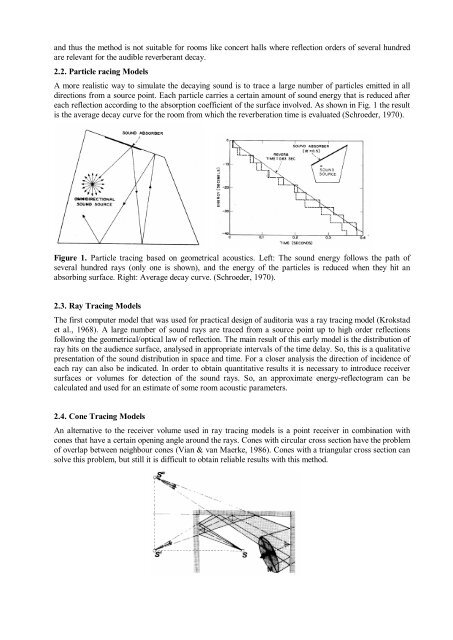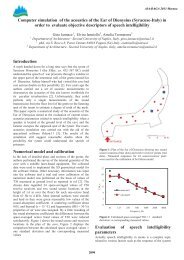ROOM ACOUSTIC PREDICTION MODELLING - Odeon
ROOM ACOUSTIC PREDICTION MODELLING - Odeon
ROOM ACOUSTIC PREDICTION MODELLING - Odeon
You also want an ePaper? Increase the reach of your titles
YUMPU automatically turns print PDFs into web optimized ePapers that Google loves.
and thus the method is not suitable for rooms like concert halls where reflection orders of several hundred<br />
are relevant for the audible reverberant decay.<br />
2.2. Particle racing Models<br />
A more realistic way to simulate the decaying sound is to trace a large number of particles emitted in all<br />
directions from a source point. Each particle carries a certain amount of sound energy that is reduced after<br />
each reflection according to the absorption coefficient of the surface involved. As shown in Fig. 1 the result<br />
is the average decay curve for the room from which the reverberation time is evaluated (Schroeder, 1970).<br />
Figure 1. Particle tracing based on geometrical acoustics. Left: The sound energy follows the path of<br />
several hundred rays (only one is shown), and the energy of the particles is reduced when they hit an<br />
absorbing surface. Right: Average decay curve. (Schroeder, 1970).<br />
2.3. Ray Tracing Models<br />
The first computer model that was used for practical design of auditoria was a ray tracing model (Krokstad<br />
et al., 1968). A large number of sound rays are traced from a source point up to high order reflections<br />
following the geometrical/optical law of reflection. The main result of this early model is the distribution of<br />
ray hits on the audience surface, analysed in appropriate intervals of the time delay. So, this is a qualitative<br />
presentation of the sound distribution in space and time. For a closer analysis the direction of incidence of<br />
each ray can also be indicated. In order to obtain quantitative results it is necessary to introduce receiver<br />
surfaces or volumes for detection of the sound rays. So, an approximate energy-reflectogram can be<br />
calculated and used for an estimate of some room acoustic parameters.<br />
2.4. Cone Tracing Models<br />
An alternative to the receiver volume used in ray tracing models is a point receiver in combination with<br />
cones that have a certain opening angle around the rays. Cones with circular cross section have the problem<br />
of overlap between neighbour cones (Vian & van Maerke, 1986). Cones with a triangular cross section can<br />
solve this problem, but still it is difficult to obtain reliable results with this method.

















